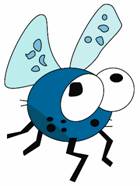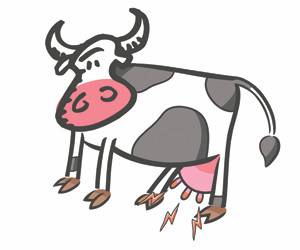Newsletter August 2019
There are many words to describe flies… however one thing for sure is they are a nuisance at this time of year! In the last few weeks there have been many cases of mastitis about causing not only issues in lactating cattle but also heifers. Mastitis has a knock on effect for both the calf and the cow herself and can cause reduced productivity, increased culling rates (due to lost quarters) and even death if they become systemically infected. There are many different approaches to both prevention and treatment of mastitis in both cattle and sheep.
 First of all prevention. As they say prevention is always better than cure! Some cows show little sign of mastitis and do not appear to be ‘clinically ill’. One of the first signs can be an empty or roaring hungry calf. Firstly at calving – hygiene is important! Many bacteria causing mastitis survive well in a dirty calving environment. As you already know clean calving areas are essential for optimising both cow and calf survival reducing incidence of disease in the herd. Fly control can help greatly reducing the incidence of summer mastitis. There are many different products on the market for keeping flies away including; creams, pour ons/spot ons, sprays, ear tags and garlic minerals. By the number of different products available, none of these are 100%! There has been resistance or lack of efficacy regarding the pour ons but at the end of the day some treatment will be much better than none! The main pour ons on the market are synthetic pyrethroids for example deltamethrins, cypermethrins. There are many brands on the market containing these drugs and all with different withdrawal periods. First of all prevention. As they say prevention is always better than cure! Some cows show little sign of mastitis and do not appear to be ‘clinically ill’. One of the first signs can be an empty or roaring hungry calf. Firstly at calving – hygiene is important! Many bacteria causing mastitis survive well in a dirty calving environment. As you already know clean calving areas are essential for optimising both cow and calf survival reducing incidence of disease in the herd. Fly control can help greatly reducing the incidence of summer mastitis. There are many different products on the market for keeping flies away including; creams, pour ons/spot ons, sprays, ear tags and garlic minerals. By the number of different products available, none of these are 100%! There has been resistance or lack of efficacy regarding the pour ons but at the end of the day some treatment will be much better than none! The main pour ons on the market are synthetic pyrethroids for example deltamethrins, cypermethrins. There are many brands on the market containing these drugs and all with different withdrawal periods.
 On to treatment of mastitis…. This can very much depend on the temperament of the cow! Treatment of the cow also depends on how sick the animal is and if there is a temperature present. Intra-mammary preparations are available – containing antibiotics. It is important to strip out the affected quarter(s) as much as possible to get the infected milk out of the cow. After doing this clean the teat well (alcohol wipes can be provided) to ensure the teat is not contaminated from the outside as it is inserted into the teat. Animals not showing clinical signs could be treated with injectable antibiotics such as broad spectrum penicillins or oxytetracyclines. It is important to ensure that treatment is given as recommended (ie Betamox lasts for 2 days and can be repeated, Synulox/noroclav requires daily injections for several days as does pen strep). Animals showing clinical signs (ie lameness, swollen udder, or dour/letheragic) can be given an anti-inflammatory/painkiller (inflacam/Metacam/loxicom) as well as an antibiotic. Drugs such as Draxxin and Micotil (which we can only inject) may be the drug of choice here. But please PHONE TO SPEAK TO A VET! The cow/heifer will commonly lose the affected quarter, so consideration should be made to see if she should be kept in the herd or culled. Mastitic milk can also affect the calf in a few ways; scour and not drinking/thriving being the main things. Toxic mastitis (which is more frequently seen in dairy cattle) can kill quickly, therefor prompt treatment should be sought – we would recommend a vet visit in this case! The udder may change colour, the animal will be sick, down, often sunken eyed and not eating. On to treatment of mastitis…. This can very much depend on the temperament of the cow! Treatment of the cow also depends on how sick the animal is and if there is a temperature present. Intra-mammary preparations are available – containing antibiotics. It is important to strip out the affected quarter(s) as much as possible to get the infected milk out of the cow. After doing this clean the teat well (alcohol wipes can be provided) to ensure the teat is not contaminated from the outside as it is inserted into the teat. Animals not showing clinical signs could be treated with injectable antibiotics such as broad spectrum penicillins or oxytetracyclines. It is important to ensure that treatment is given as recommended (ie Betamox lasts for 2 days and can be repeated, Synulox/noroclav requires daily injections for several days as does pen strep). Animals showing clinical signs (ie lameness, swollen udder, or dour/letheragic) can be given an anti-inflammatory/painkiller (inflacam/Metacam/loxicom) as well as an antibiotic. Drugs such as Draxxin and Micotil (which we can only inject) may be the drug of choice here. But please PHONE TO SPEAK TO A VET! The cow/heifer will commonly lose the affected quarter, so consideration should be made to see if she should be kept in the herd or culled. Mastitic milk can also affect the calf in a few ways; scour and not drinking/thriving being the main things. Toxic mastitis (which is more frequently seen in dairy cattle) can kill quickly, therefor prompt treatment should be sought – we would recommend a vet visit in this case! The udder may change colour, the animal will be sick, down, often sunken eyed and not eating.
If you have any questions regarding the treatment or prevention of mastitis then please get in touch!
I know its been mentioned several times before but…. Abortion vaccines. We have been informed by the drug company that Enzovax (vaccine for Enzootic Abortion) has a manufacturing issue at present. Therefore this year we will be using ‘Cevac Chylamdia’ vaccine. Due to the increased demand for this vaccine there may become a shortage in the future so we would recommend that if you will be using these vaccines then please phone to order as soon as possible so orders can be fulfilled. If you have any questions regarding abortions then speak to the vets or when ordering speak to Michelle or Anthea!
Last but not least we would like to welcome Lucy Thompson to the team. Lucy graduated from Glasgow in June and is taking over from Sarah as she goes on maternity leave.
| |
Previous Newsletters
July 2019
Blowfly
Lungworm
Pasteurella pneumonias
Ram semen testing
June 2019
Abattoir feedback
1. Abscesses
2.
Traumatic reticulopericarditis aka hardware disease.
3. Lungs
4. Liver Fluke
May 2019
Nemotidirus, a small intestinal parasite affecting young lambs
Sheep abortions especially from non vaccinated flocks
April 2019
Lamb and Sheep Abortions
March 2019
Colostrum Facts and Figures
November 2018
Liver Fluke in sheep and cattle
October 2018
Sheep scab
Lungworm Update
Beef Benchmarking Group
August 2018
Checking tups
Toxovax and Enzovax vaccinations
Vaccinating for the respiratory viruses
June 2018
The threat at this time of year of maggots
Lungworm
Pasteurella pneumonias affecting growing lambs
Ram semen testing
Vaccinating for BVD
May 2018
Nematodirus – an intestinal worm affecting young lambs
Coccidiosis affects lambs and calves from 3 weeks to 3 months
Lungworm
April 2018
You’ve picked the one, bring him home but.... is he upto the job?
March 2018
Colostrum
Increasing neonatal survival in sheep
Update about BVD
Feb 2018
Causes of abortion in sheep
Vaccinating for some of the main causes of scour
Oct 2017
Bull Semen Testing
Pneumonia: the causes
Sept 2017
Improve your efficiency - Scan your cows!
Sheep Scab
August 2017
The BVD eradication scheme
|


